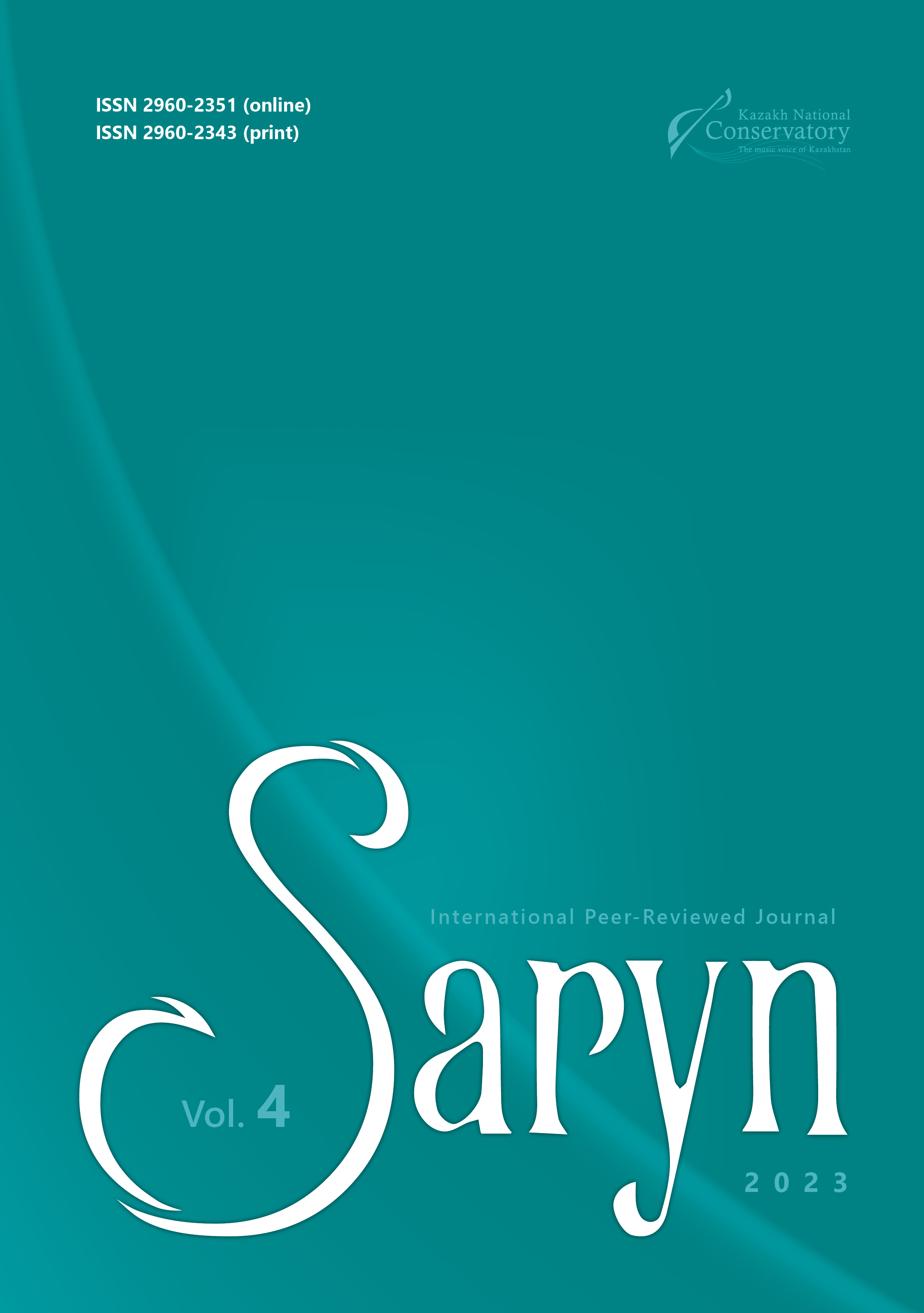Article information
Article publication date
2023-12-01
Article Page
34-53
Chapter
Arts & Humanities
License
Abstract
In the XX and XXI centuries, Kazakh music went through three waves of innovations: first, after centuries of solo-only performance, ensembles and orchestras appeared in the first decades of the Soviet period. Then, ethnographic, iconographic, and archaeological research brought back to life lost or nearly-forgotten instruments in 1970-80s, and in the 2000s new types of ensembles and neo-folk instruments appeared under global influences. All these changes were driven by two opposite tendencies: intensive cross-cultural interaction (primarily on the West-East axis) met the growing interest to the nation’s past. This neotraditional mindset influences, on the one hand, to music instrument-making, on the other hand, to performance practice.
In the first wave, the need for creating the orchestra of Kazakh folk instruments, declared by Akhmet Zhubanov, caused the foundation of the workshop where standardized dombra (plucked lute chordophone) and qobyz (bowed lute chordophone) were created together with their modernized cousins (prima, alto and bass versions). During the second wave, such prominent scholars as Bolat Sarybayev turned to a restoration of the lost instruments (sherter, zhetygen, saz syrnai, percussionand so on) that were later included in orchestras and ensembles and even institutionalized within the conservatoire’s classes. The third wave is strongly associated with various kinds of popular music. Some ensembles (as Turan and Hassak) moved toward the World music style, others (as Aldaspan) experimented in electronic and rock directions.
So, it is obvious that all three waves are interconnected. Unification and experiments with materials in the early Soviet period, as well as the creation of special workshops and laboratories for folk music, have created a systematic cycle of research and reconstructions.
Keywords
neotraditionalism in music
Kazakh music
Kazakh music instruments
modernization of music instruments
electric dombra
reconstruction of music instruments
sherter
prima qobyz
References
Abisheva, B. M. Temir uzer kylyshtyn ata bolar “Aldaspan” (interview) [orig. Kazakh: Sword Cutting Metal is Called Aldaspan (Interview) // Novaya muzykalnaya gazeta. – 2011. – No. 2, September–December. – PP. 36–38.
Alekseyev, A. D. Kazakhskaya dombrovaya muzyka [orig. Russian: Kazakh Dombra Music] / A. D. Alekseyev // Musical Culture of Kazakhstan: collection of articles. – Alma-Ata: Kazgosizdat, 1955. – PP. 50–63.
Anderson, B. Imagined Communities: Reflections on the Origin and Spread of Nationalism. – London: Verso books, 2006. – 240 p.
Bassilov, V. N. “Skifskaya arfa”: drevneyshiy smychkovyy instrument? [orig. Russian: “Scythian Harp”: The Oldest Bowed Instrument?] // Sovetskaya etnografiya. – 1991. – No. 4. – PP. 140–154.
Emielu, A. Tradition, Innovations, and Modernity in the Music of the Edo of Nigeria: Toward a Theory of Progressive Traditionalism // Ethnomusicology. – 2018. – Vol. 62. – No. 2. – PP. 206–229.
Galvan, D. Neotraditionalism. Political Science and Sociology // Britannica. – [digital source] URL: https://www.britannica.com/topic/neotraditionalism [access date: 15.09.23].
Lawergren, В. The Ancient Harp from Pazyryk // Beiträge zur allgemeinen und vergleichenden Archäologie. – 1990. – Vol. 9. – No. 10. – PP. 111–118.
Nedlina, V. E. Issledovatelskiye metody B. Sarybayeva: ofort B. Zalesskogo i perspektivy muzykalnoy etnografii Kazakhstana [orig. Russian: Sarybayev's Research Methods:
B. Zalessky's Etching and Prospects of Musical Ethnography of Kazakhstan] // proceedings of the international conference “Problems of Modern Musicology and Ethnoorganology” dedicated to the 90th anniversary of the founder of ethnoorganology in Kazakhstan Bolat Shamgaliyevich Sarybayev. – Astana: KazNUI, 2017. – 164 p.
Rancier, M. Ancient Roots, Modern Nation-Building: Kazakh Spirituality and Identity in the Music of the Turan Ensemble // Turkic Soundscapes. – London: Routledge, 2018. – PP. 214–229.
Samashev, Z. S. Muzykanty drevnetyurkskoy epokhi Kazakhskogo Altaya [orig. Russian: Musicians of the Ancient Turkic Era of the Kazakh Altay] // Madeni mura. – 2014. – No. 5 (56). – PP. 29–44.
Sarybayev, B. S. Kazakhskiye muzykalnyye instrumenty: albom [orig. Russian: Kazakh Musical Instruments: Album]. – Alma-Ata: Zhalyn, 1978. – 136 p.
Tattibaykyzy, A. Kazakhskiy kobyz v yego stanovlenii i evolyutsii v protsesse razvitiya natsionalnoy muzykalnoy kultury [orig. Russian: Kazakh Kobyz in its Formation and Evolution in the Process of Development of National Musical Culture] : dis. ... PhD in Law: 17.00.02 /
Aknar Tattibaykyzy. – St. Petersburg: Russian Institute of Art History, 2022. – 264 p. Utegaliyeva, S. I. Gde proizvodyat struny dlya dombry [orig. Russian: Where Dombra Strings Are Produced] // Chordophones of Central Asia / ed. by S. I. Utegaliyeva. – Almaty: Kazakparat, 2006. – PP. 95–99.
Utegaliyeva, S. I. Zvukovoy mir muzyki tyurkskikh narodov (na materiale instrumentalnykh traditsiy Tsentralnoy Azii) [orig. Russian: The Sound World of Music of the Turkic Peoples (Based on the Material of Instrumental Traditions of Central Asia)]: diss. ... PhD in Arts: 17.00.02 / Saule Iskhakovna Utegaliyeva. – Moscow: Moscow State Tchaikovsky Conservatory, 2017. – 527 p.
Wit and Wisdom / Johann Wolfgang von Goethe // L. A. Times Archives. – 30.07.00. – [digital source] URL: https://www.latimes.com/archives/la-xpm-2000-jul-30-bk-61292-story. html [access date: 01.11.23].




